#Subscription Billing Software for NetSuite
Explore tagged Tumblr posts
Text
Streamlining NetSuite Subscription Billing with SuiteWorks Tech: Enhancing NetSuite’s Capabilities

In today’s fast-paced business environment, managing subscriptions efficiently is crucial for success. NetSuite Subscription Billing is a powerful tool that can help businesses streamline their billing processes. However, to unlock its full potential, integrating it with a robust solution like SuiteWorks Tech is essential. This blog will explore how SuiteWorks Tech enhances NetSuite’s capabilities, providing a comprehensive subscription billing solution that not only automates processes but also elevates customer satisfaction.
The Need for Efficient Subscription Billing
As businesses transition to subscription-based models, the complexity of billing can increase exponentially. Manual processes can lead to errors, missed payments, and ultimately, dissatisfied customers. The NetSuite Subscription Billing solution addresses these challenges by automating recurring billing, but integrating it with SuiteWorks Tech takes this automation to the next level.
Understanding SuiteWorks Tech Subscription Billing Solution
Comprehensive Automation
SuiteWorks Tech subscription billing solution is natively built on the NetSuite platform, ensuring seamless integration into your existing ERP environment. This powerful billing engine automates the creation of recurring invoices, significantly reducing manual intervention. By automating these processes, businesses can focus on growth and customer service rather than getting bogged down in administrative tasks.
Key Features of SuiteWorks Tech Subscription Billing
For full blog click the below link
#Leading Subscription Billing Software for NetSuite#Best Subscription Billing Software for NetSuite#Top Subscription Billing Software for NetSuite#Subscription Billing Software for NetSuite#Subscription Billing Suiteapp#Subscription Billing solutions provider#Subscription Billing software provider#NetSuite Subscription Billing Solution#Subscription Billing solutions provider in india#Subscription Billing solutions provider in hyderabad
0 notes
Text
Leading Subscription Billing Software for NetSuite – Automate & Optimize Revenue
Looking for the leading subscription billing software for NetSuite? SuiteWorks Tech offers a robust, native NetSuite solution designed to automate your entire subscription lifecycle. From recurring billing and automated invoicing to proration, renewals, and revenue recognition, this powerful tool simplifies complex billing structures for SaaS, product, and service-based businesses. Fully integrated with NetSuite, the solution eliminates manual work, reduces errors, and boosts revenue efficiency. Whether you're managing monthly plans, annual contracts, or usage-based models, SuiteWorks Tech ensures accuracy, compliance, and scalability. Make subscription billing seamless and future-proof your billing process with SuiteWorks' trusted NetSuite-native solution.
#netsuite#Leading Subscription Billing Software for NetSuite#NetSuite Subsciption Billing#Automated Billing for NetSuite
0 notes
Text
Effortlessly Manage Recurring Revenue with NetSuite Cloud ERP

The adoption of subscriptions and recurring revenue models has affected almost every modern business in one way or another. From SaaS platforms, media companies, and professional services, income streams that can be predicted have become the new treasure for financial security. Unfortunately, most legacy systems were never designed to deal with modern billing cycle complexities, usage-based pricing, or automated renewals.
Oracle NetSuite Cloud ERP is positioned to bridge that gap. This sophisticated enterprise resource planning system does not only track transactions but also manages the entire customer lifecycle, actively transforming billing operations from a tactical necessity into a competitive advantage.
1. Flexible Billing for Every Business Model
The good thing about recurring revenue is the convenience that comes along with it. However, that very convenience can be a nightmare in itself without the right tools. Oracle NetSuite Cloud ERP can deal with everything from simple monthly subscriptions to much more complex hybrids that include fixed fees and usage-based components. Take, for example, the case of a software company that needs to bill some customers annually, while other customers are billed quarterly, and there are some who require variable rates based on API calls or storage usage. Traditional accounting systems fail under such strain, but NetSuite excels at it.
2. Subscription Management That Actually Scales:
Managing subscribers can be described as a delicate interplay between insight and precision. NetSuite Cloud ERP handles the proactive revenue optimization of subscriber management, turning reactive firefighting into a streamlined process. The system goes beyond merely accepting payments—it offers a holistic vantage point of all customer relationships. NetSuite flags high-value clients who are in danger of churning before it becomes an issue. It alerts subscription services to offer potential upsells to customers who continuously max out their limits. This level of intelligence for rapid growth businesses is crucial in achieving successful scale rather than drowning in operational complexity.
3. Focus on Royalty and Licensing Management:
Like in the media industry, software development and content platforms also face difficulties managing royalties and licensing fees. The myriads of contracts, their differing terms, payment schedules, and complex profit-sharing formulas create an intricate network of financial responsibilities that is nearly impossible to keep track of manually. Oracle NetSuite Cloud ERP provides a solution for all these headaches. Even more importantly, content creators and partners receive precise payments for their contributions on schedule - improving business relations. If a company’s most precious asset is their intellectual property, there is no suitable alternative to his level of financial clarity.
4. Unified Financials: From Billing to Revenue Recognition:
Ensuring compliance isn’t simple, as miscalculations at this stage can lead to restatements, audits, and loss of investor trust. NetSuite Cloud ERP simplifies compliance at every level by automating deferred revenue, revenue allocation, and amortization schedule management over multiple reporting periods. For publicly traded companies or those looking to go public, convenience matters less than avoiding dire financial threats using compliance regulations that protect investors and regulators.
5. What Makes NetSuite Unique Among Others in the ERP Industry:
Among all enterprise resource planning systems, Oracle NetSuite Cloud ERP sits atop the competition for its inherent grasp of businesses with subscription models. While other systems slap on subscription handling as an afterthought, NetSuite was designed from the ground up to manage the complexities of modern business models. Perhaps most importantly, NetSuite adapts to your business growth, managing everything from a startup's first hundred subscribers to an enterprise with millions of customer relationships. Connecting to an always-changing business world is easier with an ERP system without costly tailoring, and NetSuite stands out among the rest.
In our time, one of the most important changes in business is the shift to recurring revenue models. However, none of this is possible without effort. Oracle NetSuite Cloud ERP Systems will change the situation by automating key processes like billing, customer management, and finances, transforming the concept of recurring revenue into a real competitive advantage. SoftCore Solutions, proudly recognized as one of the best Oracle NetSuite Cloud ERP partners in India, further cements this.
FAQs
1. Can NetSuite handle complex subscription tiers?
Careful management of complex subscription tiers is NetSuite’s strong suit. It fully supports simple and flat-rate subscriptions as well as more hybrid systems with fixed, usage-based, and tiered pricing.
2. Does NetSuite adhere to the revenue recognition standards?
The system inherently complies with ASC 606 and IFRS 15 by automating revenue allocation for different time periods and preserving detailed audit trails for effortless financial reporting and auditing.
3. Where can I search for NetSuite specialists in India?
In addition to Oracle, you can search for local implementation gurus using the network of authorized NetSuite partners in India, as these offer training and ongoing maintenance tailored to your business.
0 notes
Text
An Ultimate Guide of NetSuite Implementation for SaaS Companies in 2025

Seamless management of operations and finance is the primary factor enabling SaaS companies to expand their growth over time. However, continuous growth in the SaaS industry creates difficulties for effective management and efficient handling of financial activities alongside subscriptions and customer databases.
The cloud-based ERP system, i.e., NetSuite, delivers a single platform that integrates financial management with CRM solutions, billing capabilities, and revenue recognition features. However, it is quite challenging to handle the process of NetSuite implementation. Let’s have a deep dive into how NetSuite implementation strategies can be a powerful weapon in the hands of SaaS companies.
Need for NetSuite Implementation for SaaS Companies
Implementing NetSuite enables SaaS companies to automate critical financial operations and increase operational effectiveness. It emerges as the cloud-based ERP solution that resolves numerous business challenges through its following features:
Automated Revenue Recognition: It reduces the chance of manual mistakes and audit-related threats with its ASC 606 and IFRS 15 compliant financial reporting services.
Subscription Management: The solution offers automated billing features for subscription renewals and plan upgrades, resulting in consistent customer interactions.
Financial Visibility: It provides immediate financial assessment with advanced analytical reports, enabling SaaS companies to quickly follow essential financial data points.
Scalability: It provides growing businesses with features to handle multi-entity structures, multiple currencies, and worldwide financial operations that simplify their expansion process.
Top 5 Challenges in NetSuite Implementation for SaaS Companies
Implementation of NetSuite provides enhanced automation and scalability together with clear financial visibility. Such a process seems to be easy, but it is not. It has to address the following challenges:
1. Customization & Configuration Complexity
Many SaaS companies underestimate the complexity involved in configuration to meet their specific requirements. These companies are unaware of the fact that excessive customization makes system updates harder, increases maintenance costs, and extends technical issues.
2. Data Migration Difficulties
Successful migration processes should be structured appropriately as they prevent operations from halting and prevent inaccurate reporting and data corruption or loss. Organizational risk reduction comes from transparent data migration planning systems that integrate data purifying and confirming measures to deliver bold data transitions.
3. Integration Challenges
A SaaS business requires NetSuite to support the current operation of CRM platforms, payment gateways, and customer support software. The absence of effective system integration creates data storage spaces with conflicting data. This also diminishes operational decision quality and total operational performance.
4. User Adoption Issues
NetSuite implementation power becomes useless if employees find it challenging to operate the system. As a result, it becomes essential to opt for an organized change management approach combined with practical training, employee involvement, and constant support. Such an approach is a direct door for an easy adaptation of the NetSuite.
5. Compliance and Regulatory Risks
SaaS companies must fulfill various financial and data protection requirements comprising tax laws, GDPR standards, and ASC 606 compliance guidelines. Inadequate implementation setups present businesses with various compliance issues that result in financial penalties and system operation problems.
Also Read: NetSuite for SAAS Companies
8 Best Practices for a Successful NetSuite Implementation
The successful optimization of operations for SaaS companies depends entirely on achieving well-defined objectives and qualified employee training throughout each succession step of NetSuite implementation. To maximize NetSuite's implementation benefits, demands for the following best practices:
1. Define Clear Business Objectives
Every effective NetSuite implementation depends on having established performance goals from the company. Since NetSuite needs to serve company needs and ensure lasting growth strategy implementation, the presence of established objectives allows the system to match business requirements.
2. Choose the Right NetSuite Edition
NetSuite provides its solutions specific to SaaS business requirements. Companies can choose the right edition from SuiteSuccess for Software or Subscription Billing. This helps the companies manage ASC 606 compliance, automate billing cycles, and track deferred revenue to improve efficiency and ensure regulatory compliance.
3. Involvement of Stakeholders
A successful NetSuite implementation requires cooperation from different departments of the organization. To ensure the smooth running of the integration process, key team members, such as sales, finance, IT, and customer support must work in collaboration with each other. Such cooperation will help in the detection of integration points early and also make a balance with existing workflows to simplify the essential processes.
4. Plan Data Migration Strategically
SaaS businesses face significant data migration challenges when they handle massive quantities of customer data, financial records, and subscription management requirements. The migration process should incorporate staged implementation by first cleaning and validating the data so inconsistencies remain eliminated while minimizing data loss to help achieve system transition success.
5. Leverage NetSuite’s Automation Capabilities
NetSuite implementation enables automated execution of recurring billing and revenue recognition processes, financial reporting, and compliance tracking. This allows SaaS companies to achieve improved efficiency levels, reduced manual errors, and enhanced resource allocation toward strategic business initiatives.
6. Ensure Seamless Integration with Third-Party Applications
Most SaaS businesses depend on a combination of Salesforce as their CRM system, Stripe for payment handling, and Zendesk for customer support operations. An optimized integration between NetSuite and third-party applications improves workflow consistency and produces complete data coherence while eliminating unnecessary processes.
7. Invest in Employee Training and Support
Introducing a new ERP system often leads to significant changes throughout daily operational activities. Providing structured training, simple guides, and ongoing support helps employees learn NetSuite effectively. This reduces disruptions, maximizes system use, and increases return on investment.
8. Partner with an Experienced NetSuite Implementation Partner
Implementing systems with NetSuite specialists who possess experience produces enhanced setup results with improved workflow design capabilities and solution quickness. This will ultimately help SaaS companies reduce implementation time while minimizing risks. You can seek help from NetSuite implementation partner to allow your SaaS businesses to enhance their operations and scale their business efficiently without sacrificing compliance requirements.
Conclusion
The SaaS industry benefits significantly from NetSuite as this cloud-based solution enables real-time tracking plus operational scalability with automated processes. SaaS companies can achieve a smooth NetSuite transition and long-term success by implementing best practices with the expert team of VNMT Solutions. We strive to deliver the best implementation services specifically designed to address the needs of SaaS business operations.
#NetSuite Implementation#NetSuite for SaaS Companies#NetSuite Implementation for SaaS Companies#NetSuite#SaaS Companies#VNMTSolutions
0 notes
Text
Affordable Open-Source Alternatives to Pricey SaaS Tools
In today's SaaS-driven world, businesses often find themselves locked into expensive subscription plans for essential tools. While these platforms offer robust features, they may not always be cost-effective for startups, solopreneurs, or small teams. Fortunately, open-source alternatives have emerged as powerful, budget-friendly options without sacrificing functionality.
Here’s a look at some of the best open-source platforms that can replace pricey SaaS tools, helping businesses save money while staying productive.
1. UniBee – AI-Powered Subscription & Payment Management
If you're looking for an alternative to pricey subscription management and financial analytics tools, UniBee is a solid open-source contender. Designed for businesses that need seamless payment tracking and financial insights, UniBee offers AI-powered analytics, automated billing, and integration with popular payment gateways. Unlike traditional subscription management SaaS that lock you into expensive tiers, UniBee gives you flexibility with an open-source approach and cost-effective scaling.
Best Alternative to: Recurly, Chargebee, or Paddle
2. Odoo – Open-Source ERP & Business Suite
ERP and business management tools like NetSuite and SAP can be prohibitively expensive. Odoo provides a modular, open-source alternative covering everything from CRM and invoicing to inventory and HR management. With a free community edition and affordable add-ons, Odoo lets businesses build a tailored solution without breaking the bank.
Best Alternative to: NetSuite, SAP, Zoho One
3. Matomo – Privacy-Focused Web Analytics
Google Analytics is powerful, but concerns over data privacy and hefty enterprise plans have driven businesses to explore alternatives. Matomo is a self-hosted, open-source analytics platform that offers full data ownership and compliance with privacy laws. It provides robust tracking features, heatmaps, and conversion insights—minus the privacy trade-offs.
Best Alternative to: Google Analytics, Adobe Analytics
4. Kimai – Open-Source Time Tracking
For businesses tired of paying high monthly fees for time tracking software like Toggl or Harvest, Kimai offers a lightweight, open-source solution. It supports multi-user tracking, invoicing, and reporting, making it ideal for freelancers, teams, and agencies looking for a free yet powerful alternative.
Best Alternative to: Toggl, Harvest, Clockify
5. Rocket.Chat – Secure Team Communication
Slack and Microsoft Teams dominate the market, but they can be costly for large teams. Rocket.Chat is a self-hosted, open-source messaging platform that offers real-time collaboration, video conferencing, and integrations—all while allowing companies to keep control of their data.
Best Alternative to: Slack, Microsoft Teams, Discord
Final Thoughts
While paid SaaS tools often lead the industry in terms of features and ease of use, open-source alternatives offer an excellent way to cut costs, customize solutions, and maintain control over your data. Whether you're managing subscriptions, tracking analytics, or collaborating with a team, open-source platforms like UniBee, Matomo, and Odoo provide affordable yet feature-rich solutions for businesses of all sizes.
Have you tried any of these tools, or do you have a favorite open-source alternative? Let me know in the comments!
0 notes
Text
https://www.advancemarketanalytics.com/reports/16160-global-accounting-software-market-2
What Challenges Accounting Software Market May See in Next 5 Years
Advance Market Analytics released a new market study on Global Accounting Software Market Research report which presents a complete assessment of the Market and contains a future trend, current growth factors, attentive opinions, facts, and industry validated market data. The research study provides estimates for Global Accounting Software Forecast till 2029*.
Accounting software is a fundamental application that enables an organization to record the flow of money for internal and external review and auditing. It is the primary tool for assessing the financial health of an organization and for meeting legal compliance through tools like general ledgers, purchase orders, account payables & receivables, stock management, and billing.
Key Players included in the Research Coverage of Accounting Software Market are:
Intuit Inc. (United States), Sage Software Inc. (United States), SAP SE (Germany), Oracle Corporation (United States), Microsoft Corporation (United States), Infor Inc. (United States) , Horizon Technology Solutions (India), Zoho Corp (India), FreshBooks (Canada), NetSuite (United States), Deltek (United States),
What's Trending in Market: Users Prefer Cloud-Based Systems to On-Premise
The Adoption of Automation The Era of Millennial Clients
Challenges: Competition is increasing due to Corporate Bookkeeping Firms
Scalability and customization Lack of integrations
Opportunities: The Rising Demand for Accounting Software from the Micro & Small Scale Enterprises
Market Growth Drivers: Increased Efficiency with the use of Accounting Software
Increasing Adoption of Cloud-based Applications Ease of Integration with Existing Software Platforms
The Global Accounting Software Market segments and Market Data Break Down by Type (Billing and invoicing systems, Payroll management systems, Enterprise resource planning systems, Time and expense management systems), Deployment Mode (Cloud-based, On-Premises), Organization Size (Small & Medium Size Enterprise, Large Enterprises), Platform (Windows, Mac, Android, Others), Industry Verticals (BFSI, IT & Telecommunications, Public & Government Sector, Automotive Sector, Retail & Consumer Goods, Oil & Gas, Manufacturing, Healthcare, Construction & Real Estate, Education, Media & Entertainment, Others), Pricing (Monthly Subscription, Annual Subscription, One-Time License)
Get inside Scoop of the report, request for free sample @: https://www.advancemarketanalytics.com/sample-report/16160-global-accounting-software-market-2
To comprehend Global Accounting Software market dynamics in the world mainly, the worldwide Accounting Software market is analyzed across major global regions. AMA also provides customized specific regional and country-level reports for the following areas.
• North America: United States, Canada, and Mexico.
• South & Central America: Argentina, Chile, Colombia and Brazil.
• Middle East & Africa: Saudi Arabia, United Arab Emirates, Israel, Turkey, Egypt and South Africa.
• Europe: United Kingdom, France, Italy, Germany, Spain, Belgium, Netherlands and Russia.
• Asia-Pacific: India, China, Japan, South Korea, Indonesia, Malaysia, Singapore, and Australia.
1 note
·
View note
Text
Best 4 Netsuite Features & ERP Functions For Boosted Growth!
Oracle NetSuite, being the top ERP solution for global brands ranging from small scale companies to large corporations, has been alert about enhancement of NetSuite features round the clock. The company runs surveys where NetSuite users input their opinions about the software, recommend or ask for certain features from scratch or updates in existing features.

The NetSuite team had run a similar kind of a survey in November 2022- CFO.com/NetSuite, where all the CFOs were asked about their challenges & scope of advancements in the software.
After the analysis of survey results, NetSuite has taken no longer to offer apt solutions. It’s right here! The NetSuite 2023.1 Release has been crafted around the mitigation strategy for Accounts & Finance departments. These NetSuite features will resolve concerns around economic conditions, cash flow, and other challenges of CFOs & Finance personnel.
Let’s Check Out The NetSuite Features & Benefits For Finance:
1. Simplified Accounts Payable Automation:

Automating the bill capture process through payment capabilities offers a simplified approach to accounts payable (AP) automation. Manual data entry is often inefficient, time-consuming, prone to error, and can lead to higher costs, missed savings, and increased risk of fraud. By automating the process, companies can avoid these issues and ensure smoother AP operations.
One of the NetSuite features allows the use of AI/ML-based object detection and optical character recognition. As a result, emailed bills can be automatically processed to create digitized versions.
This eliminates the need for manual input of vendor details or scanning and dragging a version into the bill capture workspace. The relevant details, such as vendor name, PO number, items ordered, quantity, and pricing, are converted into digital text and matched to the purchase order for more efficient bill processing.
NetSuite’s AP Automation includes enhanced payment automation capability with HSBC banking services for faster and accurate payments made within NetSuite. NetSuite 2023.1 offers further efficiencies with automated journal entries and an enhanced approval routing workflow.
The update eliminates manual entry of payment details and ensures accurate vendor information, reducing the risk of missed or late payments and preventing the creation of fraudulent suppliers.
2. Automated Price Change for Subscription Renewal:

Companies with subscription pricing options can reduce the administrative burden and save time by automating their renewal processes. One of the NetSuite features from its 2023.1 version introduces the “uplift at renewal” feature, allowing SuiteBilling users to apply a percentage increase to a customer’s renewal pricing.
This simplified feature offers flexible preferences, making it easy to keep pace with inflation or shift to the latest catalog pricing, ensuring subscription revenue growth for all business models.
3. Improved Capabilities Around Indirect Cost Allocation:

Now this is another exciting characteristic from NetSuite Features! NetSuite 2023.1 enhances not-for-profit capabilities with better indirect cost allocation. Users can enter provisional or agreed-upon rates for custom segments and tag allowable direct costs with any amount limits. The update automatically calculates indirect costs and displays total costs, enabling organizations to recover indirect costs from a custom segment.
4. Increased Control Around Tax Exemption:

NetSuite 2023.1 introduces a new feature that offers flexibility to companies that are tax exempt or have tax-exempt subsidiaries. With this update, users can disable tax calculation where it is not required, and instead, assign nexuses to a subsidiary, classify it as tax exempt, and skip the assignment of a tax engine. This means that tax calculations on transactions for that nexus will be effectively disabled.
This feature enables companies to run both tax-exempt and tax-registered businesses within the same NetSuite account. This provides a convenient way for companies to manage their tax obligations without the need to switch between different systems or create separate accounts. By disabling tax calculations where they are not required, companies can save time and reduce the risk of errors, while still maintaining compliance with tax regulations.
Conclusion:
Excited to try out these NetSuite features & benefits and boost the productivity of the Finance Department by 2X in your NetSuite Account? Consult our Experts at Integs Cloud. We are expert NetSuite Solution Providers!
Know more at https://integscloud.com/blog/netsuite-features-erp-functions-for-boosted-growth/
#IntegsCloud#OracleNetSuite#ERP#BusinessEfficiency#NetSuite#NetSuiteImplementation#Integration#Automation#API#SaaS#Enterprise#Tech#Technology#Software#Celigo#iPaaS
0 notes
Text
OpenTeQ NetSuite ERP Support|NetSuite Project Implementation| NetSuite Accounting Partner
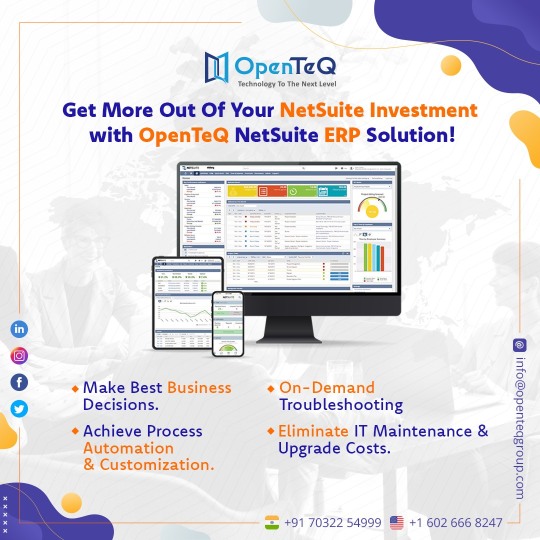
Accounting Software Migration With NetSuite & Best Practices!
In this blog we discuss about Accounting Software Migration and how NetSuite ERP Implementation offers a portfolio of business applications on a single platform.
To ensure high service quality standards that generate customer satisfaction, service organizations must track and monitor their resources operating across numerous projects. Oracle NetSuite, for example, provides service organizations with a comprehensive solution that is geared to assist them in completing successful projects.
Across the globe, organizations begin with entry-level software to support their essential capabilities, including accounting, finance, inventory, and human resources. QuickBooks and Tally have practically become de facto business software for startups and mid-sized organizations. Some even provide extra features such as support add-ons and third-party systems to enhance their functionality.
However, organizations eventually outgrow such entry-level business software.
Even while standalone accounting software is commonly used, many organizations find it difficult to run their company comfortably with it after a certain point. This is especially true for high-growth organizations that have been in operation for some time and are still expanding.
Accounting software or other stand-alone software users confront the following challenges:
1) Inadequate real-time reporting: Entry-level software skills are often insufficient for providing aggregated views and real-time data. This is primarily due to employees' reliance on data dispersed across spreadsheets to fill information gaps. Furthermore, the organization relies on manual operation for non-existent functions such as reconciling customer and debtor information, or in the cost of purchasing out or manufacturing things. In such cases, organizations may deploy stand-alone applications and face integration issues with critical accounting software. This obviously causes delays in processing and reporting. When information access and availability take longer or become more complex, it is an indicator that the programme has surpassed the company demands.
2) System integrations: Standard accounting software is not designed to handle growing numbers of customers, vendors, inventory, and orders. Greater transaction volumes and faster consolidations are the major drivers for expansion and success, yet most of these applications cannot handle such demand. Complete audit trails, intelligent business planning, real-time reporting, and automated workflows would necessitate the integration of other apps and systems. In the lack of perfect integration, one is simply contributing to the hairball of spreadsheets. Furthermore, such stand-alone software cannot manage stricter financial controls or support sophisticated financial operations such as subscription billing and invoicing.
The most critical challenges faced by accounting and finance teams today, according to a study published by the Institute of Management Accountants, are integrating disparate business systems, adding business intelligence software, and replacing disparate systems with a single business suite and database.
3) Extensive Manual Intervention: Incompatibilities across systems and inadequate integrations have forced employees to shift data manually, resulting in human errors and reporting delays. Every week, employees put in long hours entering order information into the invoicing system, while someone from sales copies invoice details into the sales compensation spreadsheet. Such human data entry generates billing queries, which, if not answered in a timely manner, might lead to a month-end disaster. When paperwork is handed around to be confirmed with information from separate systems, simple activities like expense claim approvals or regular contract signatures might take a few days to weeks to complete. With data scattered across multiple systems, it becomes difficult to obtain real-time information in the appropriate format for trend analysis, thus staff fill the data gap with speculation rather than genuine data that is difficult to locate.
4) Lack of scalability When a company wants to grow, transform, go digital, or respond to market possibilities and competitive challenges, it need advanced and specialized functions. Entry-level accounting software lacks industry-specific functionality such as prepayments, production, inventory, or warehouse distribution, necessitating the usage of additional standalone software with integration complexity.
And maintaining data integrity while handling increasing volumes becomes a difficulty. Embracing mobile solutions to improve user experience while speeding up information access and decision-making has become a speciality of apps like NetSuite, a go-to application for all Digital Transformation needs.
5) Agility: Adding sales channels, product lines, or locations in accounting software becomes too difficult. When there is a change in business, employees must work overtime, or new employees are hired to accommodate the changes. A procedure that begs for automation is carried out manually or via spreadsheets, making scale-up time-consuming and labor-intensive.
Adding sales channels, product lines, or locations in accounting software becomes too difficult. When there is a change in business, employees must work overtime, or new employees are hired to accommodate the changes. A procedure that begs for automation is carried out manually or via spreadsheets, making scale-up time-consuming and labor-intensive.
NetSuite ERP Implementation offers a portfolio of business applications on a single platform, including extensive financial features. NetSuite's financial management features provide real-time reports by combining fundamental accounting and financial tasks with excellent compliance management.
How might the advanced financial aspects of NetSuite be useful?
1) Bookkeeping
Complete accounting functionalities (GL, AR, AP, TM, FAM, PM) are integrated on a single platform to deliver real-time visibility and intelligent insights for financial control.
2) Billing
By centralizing all billing procedures, it provides real-time visibility into financial and billing activity. By integrating Suite Billing Features- (subscription management, pricing models, rating engine, billing schedule, change orders, subscription self-service, recurring revenue recognition, reporting), it manages subscription billings with auto-renewal, consolidates invoices, and supports multiple pricing models.
3) Budgeting and Planning
Allows firms to undertake financial planning and budgeting with modeling capabilities for both departments and the company using approval workflows and reporting. This is accomplished by combining planning and budgeting elements (budgeting and planning, scenario planning and modeling, revenue planning, operational expense, workforce planning, trended financial statements, data synchronization, dashboards, and Microsoft Office interface) on a single scalable system.
4) Revenue Recognition
By integrating revenue recognition capabilities (Allocations, Rules & Schedules, Revenue Plan Management, Forecasting & Reporting), firms may comply with accounting standards, report on time, and respond to evolving revenue recognition demands.
5) Financial Reporting
Provides detailed insights for educated decision-making with pre-configured role-based financial dashboards, reports, and KPIs. Additionally, it aids in the generation of accounting-compliant financial reports and statements by combining reporting features such as Configurable Financial Reports, Report Snapshots, Multidimensional Analysis, and Multiple Reporting Standards.
6) Financial Consolidation
Assists businesses in combining disparate financial and accounting procedures, financial assets, data, and reporting across all units, subsidiaries, and locations in accordance with tax regulations and compliance. All of this is accomplished by combining consolidation characteristics (consolidation, multiple tax and accounting standards, and intercompany accounting) on a single platform.
7) Governance, Risk, and Compliance
Assists firms in legitimizing GRC programmes through audit-ready solution support. Furthermore, by combining GRC capabilities (Automate controls, Audit trails, Third-Party Audit reports, Security Monitoring, Audit & Compliance reporting, and Securing Master data), it manages evolving compliance, regulatory, and operational needs with extensive built-in reports and certificates.
NetSuite ERP Consulting, the All-In-One Solution
By decreasing the need for extra business applications, NetSuite's ERP functionalities enable the complete firm to operate on a single platform. A NetSuite Solution Provider can help you successfully implement and fully utilize the ERP Solution. When a company expands, so does the number of customers, orders, inventory, workers, data, and workflows. All of these are accommodated by NetSuite ERP features on its cloud platform.
1) Accounting Software
NetSuite's accounting software unites accounting and financial apps (GL, AP, AR, TP, FAM) on a single platform to provide compliant financial closing.
2) Order Management
NetSuite order management combines (multi-channel order management, revenues Order Management, Returns Management, and Price Management) on a single platform to enable order visibility across channels for efficient order processing and higher revenues.
3) Inventory Management
NetSuite Inventory Management combines multi-location fulfilment, replenishment, cycle counting, and traceability on a single platform for optimal inventory usage and accurate inventory planning.
4) Warehouse Management
Inbound logistics, order fulfilment, mobile warehouse management, and bin management for intelligent pick & pack, warehouse space & stock utilization are all features of NetSuite.
5) Supply Chain Management
NetSuite offers supply planning and supply chain execution tools to ensure consistent stock quality, stock availability, and timely stock delivery across the supply chain.
NetSuite implementation partner can help you successfully implement and fully utilize the ERP Solution. Using a single NetSuite Integration Platform to replace entry-level accounting software and supplementary applications will streamline all business activities and provide the organization with real-time visibility and reporting across channels. Stay tuned with OpenTeQ for more updates on NetSuite ERP Consulting. Reach out at [email protected] or contact to know more at +91 70322 54999 /+1 602 666 8247!
#netsuite implementation team#netsuite accounting partner#netsuite consultation#netsuite crm#netsuite customer support & customization#netsuite development#netsuite erp consulting#netsuite health check#netsuite implementation consultant#netsuite implementation services#netsuite partne#netsuite integration
0 notes
Text
Request A Sage X3 Demo
Use of free trial and demo software is done at your threat and you will not maintain Commercient LLC responsible for any knowledge loss or corruption. We’ve seen, first hand, how game-changing this software program could be and it's our objective to deliver the benefits of the cloud to as many corporations as we will. Offer your small business a novel integration, arranging the connection and authentication to Magento and SAP. A lot of customized coded or third-party connections result in knowledge silos.
Also hear instantly from customers report their direct benefits as result of their ERP implementation. Process manufacturing requires ERP software which will monitor uncooked supplies, as properly as their effectivity, shelf life, batch or lot quantity sage x3 demo and general high quality. Epicor® helps service firms meet their biggest problem which is to satisfy client’s needs sage x3 chemical and expectations whereas maintaining profitability.
Choose from a range of customizable GPS tracking options that provide dashboards, reports and alerts. Pacejet’s integration with Sage X3 allows you to simplify workflows and cut back prices at every stage of your transport process, saving time and money so you can grow your small business. Sage X3 offers useful assets in the standard package deal which are tough to search out in competing merchandise. That’s why Sage X3 is one of the most cost-effective ERP systems on the market. Automate transfer of information reviews between techniques, including international locations and subsidiaries.
Since 2002, 360 Cloud Solutions has helped tons of of fast-growing corporations enhance their business agility by leveraging NetSuite, Adaptive Planning, and 360 Subscription Billing—along with other powerful, cloud-based instruments. From licensing to implementation, providers and ongoing assist, we do it all. You can create mappings for your Shopware codecs, which may be saved as pre-built integration templates. These templates are
Buyers use our vendor rankings to shortlist companies and drive requests for proposals (RFPs). Reach 1000s of buyers who use CB Insights to determine vendors, demo merchandise, and make buying selections. NetSuite has in depth knowledge base (SuiteAnswers) obtainable to all customers in addition to online person group.
mitigate danger, and coach your drivers with HD video, AI and driver safety information. Monitor heavy tools, trailers and assets to enhance security, utilization and uptime. "The CFO and I can pull up the info and see the place our money is at any time. It’s actually been a life saver, particularly throughout these uncertain instances."
We’re more than happy to have this resolution in place to gear up for the long run. Put fairly simply, Sage X3 delivers extra of what you need–performance, insights, and scalability. And much less of what you don’t–complexity, tough customizations, and high overhead prices.
0 notes
Text
Group Accounting Software Market Growing Popularity and Emerging Trends in the Industry
The Latest Released market study on Global Group Accounting Software market provides information and useful stats on market structure, size and trends. The report is intended to provide cutting-edge market intelligence and strategic insights to help decision makers take sound investment decisions and identify potential gaps and growth opportunities. Besides, the report also identifies and analyses changing dynamics, emerging trends along with essential drivers, challenges, opportunities and restraints in Group Accounting Software market. What’s keeping Sage Intacct (United States),OneStream Software (United States),NetSuite Inc. (United States),Workday Adaptive (United States),Oracle Corporation (United States),Intuit Inc. (QuickBooks) (United States),LucaNet AG (Germany),IBM (United States),CFOUR (United States),AccountsIQ (United Kingdom),CCH Tagetik (Italy),AccountantsWorld (United States),Access Group (United Kingdom) Keep Growing in the Market? Benchmark yourself with the strategic moves and latest Market Share and Sizing of Global Group Accounting Software market recently published by AMA Group accounting software is utilized in the accounting and financial operations of a group of companies. The group accountants use this software tool to consolidate subsidiaries for statutory reporting applications ensuring that all entities within the group follow the correct accounting standards. This software helps businesses to assess their financial health and meet the legal companies through accounting tools such as account payables, general ledgers, accounts receivables, stock management, billing, and others.
The Group Accounting Software Market segments and Market Data Break Down by Application (Large Size Enterprises, Small and Medium Size Enterprises), Pricing (Annual Subscription, Monthly Subscription), Deployment (On-Premises, Cloud-based), Features (Budgeting/Forecasting, Financial Reporting, Payroll Management, Others)
On the geographical front, the market has been segregated into North America (the United States and Canada), Europe (Germany, France, the United Kingdom, Italy, Spain, Russia and others), Asia Pacific (China, Japan, India, South Korea, Australia, Indonesia and others), Latin America (Brazil, Mexico and others), and Middle East and Africa.
What’s Trending in Market : Integration of Predictive Technology in Group Accounting Software
Market Challenges: Stiff Competition in the Group Accounting Software Market
Market Opportunities: Surging Demand for the Group Accounting Software from Large Size Businesses Primarily Dealing with Investments and Banking Operations
Highlights of Influencing Drivers: Growing Number of Financial Businesses
Need for Managing the Financial Operations for Managing Ledgers and Payables Presented By
AMA Research & Media LLP
0 notes
Text
Boost Efficiency with SuiteWorks Tech Subscription Billing SuiteApp

Suite Works Tech is a leading subscription billing solutions provider in India, offering the best NetSuite Subscription Billing SuiteApp to supercharge your operations. As a top subscription billing software provider in Hyderabad, we specialize in delivering tailored solutions for businesses using NetSuite. Whether you need advanced subscription billing software for NetSuite or an innovative subscription billing solution, our expertise ensures seamless implementation and enhanced productivity. Optimize your billing processes with the best subscription billing software for NetSuite today!
#Leading Subscription Billing Software for NetSuite#Best Subscription Billing Software for NetSuite#Top Subscription Billing Software for NetSuite#Subscription Billing Software for NetSuite#Subscription Billing Suiteapp#Subscription Billing solutions provider#Subscription Billing software provider#NetSuite Subscription Billing Solution#Subscription Billing solutions provider in india#Subscription Billing solutions provider in hyderabad
0 notes
Text
ERP Software & Business Accounting Software to Support Your Growing Business Needs

Many businesses have been launched by the popular'shrinkwrap' solutions Quickbooks and Peachtree. These products are flexible and easy-to-use. They also have two-dimensional reporting which is a great feature for accounting and other advanced areas such as project billing and procurement management.
Some business owners might wonder when it is time to leave. There are many good reasons to move on, but I'll only highlight a few. You may have an Ecommerce solution that is standalone and does not need to be connected to your accounting system. You may also be using ACT!, Salesforce.com, or Goldmine to automate sales. However, the quoting and customer master data are not linked to your accounting system items. These integrated systems can be used to standardize pricing for customers, items, promotions, and even dealers (partners) in both of these cases.
People who use spreadsheets for simple scheduling and production planning functions may have the greatest justification. Spreadsheets can lead to companies wasting time and allowing for errors. Once your production schedule is completed, there is almost no way to 'put back' the accounting system. A back-office system that integrates planning and scheduling can be used to reduce inventory, improve customer service or reduce lead time. You may also be able increase your bottom line if you are able to add an "available to promise", to commit an order for a key prospect/customer.
Netsuite Vs Salesforce You may be wondering why your servers are growing from an IT infrastructure perspective. It is much easier to add servers to all of these systems than to consolidate them on one server. This increases complexity and your dependence on expensive IT personnel.
An online subscription-based solution that combines ERP and CRM in one easy solution is available. You only need a web browser, and a high-speed line. Small businesses can reap the benefits of:
1) Reduce automation 'islands' that are difficult to rekey and encourage mistakes 2) Reduce dependence on IT personnel and internal systems 3) Explore advanced integration areas such as aftermarket service, scheduling/planning, configuration management, comprehensive sales force automation, and Ecommerce.
0 notes
Text
Online Subscription Management Software Market is Booming Worldwide | SubscriptionFlow, NetSuite, Zuora, SaaSOptics
Advance Market Analytics published a new research publication on “Global Online Subscription Management Software Market Insights, to 2027” with 232 pages and enriched with self-explained Tables and charts in presentable format. In the study, you will find new evolving Trends, Drivers, Restraints, Opportunities generated by targeting market-associated stakeholders. The growth of the Online Subscription Management Software market was mainly driven by the increasing R&D spending across the world.
Major players profiled in the study are:
NetSuite (United States), SubscriptionFlow (United Kingdom), Zoho Corporation (India), Subbly Limited (Scotland), Zuora (United States), SaaSOptics, LLC (United States), Sage Intacct, Inc. (United States), Cougar Mountain Software (United States), Deskera (United States)
Get Exclusive PDF Sample Copy of This Research @ https://www.advancemarketanalytics.com/sample-report/101634-global-online-subscription-management-software-market#utm_source=DigitalJournalVinay
Scope of the Report of Online Subscription Management Software
Online subscription management software is the automation in managing the subscription for the products and services online that allows the timely monthly or annual billing options and marketing activities. The increasing number of SaaS businesses across the world is contributing to the increase in the online subscription management software market. The software manages all the processes of managing the free trial of the product or service, issuing refunds, making subscriptions, and many other things.
On 22nd January 2020, SaaSOptics, the only subscription management platform designed for emerging and growing B2B SaaS and subscription-based businesses, announced its integration with cloud-based accounting platform Xero. The integration allows B2B SaaS businesses to seamlessly use SaaSOptics alongside Xero to mature their financial operations, manage the entire order-to-cash and renewal process, and gain the metrics, analytics, and reporting needed to get funded, stay funded and grow.
The Global Online Subscription Management Software Market segments and Market Data Break Down are illuminated below:
by Type (Recurring Billing, Self Service Portal, Subscription Plan Management), Application (Small and Medium Enterprises (SMEs), Large Enterprises), Platform (Desktop, Smartphones, Tablet), Deployment (Cloud-based, On-premises), Features (Cancellation Management, Discount / Coupon Management, Enrollment Management, Revenue Recognition, Trial Management, Usage Tracking/Analytics, Others)
Market Opportunities:
Surging Consumption of Online Platform for various Activities Like Shopping, Entertainment, and Other Activities will Boost the Online Subscription Management Software
Market Drivers:
Demand for Automation in Handling the Monthly Subscription Payment Online Accurately and Effectively with the Less Error
Increasing Consumption of Subscription-based Software in an Organisation
Market Trend:
Rising SaaS Business Worldwide Leading to the Popularity of Online Subscription Management Software
Increasing Use of Online Subscription Management Software for Online Payment and its Convenience
What can be explored with the Online Subscription Management Software Market Study?
Gain Market Understanding
Identify Growth Opportunities
Analyze and Measure the Global Online Subscription Management Software Market by Identifying Investment across various Industry Verticals
Understand the Trends that will drive Future Changes in Online Subscription Management Software
Understand the Competitive Scenarios
Track Right Markets
Identify the Right Verticals
Region Included are: North America, Europe, Asia Pacific, Oceania, South America, Middle East & Africa
Country Level Break-Up: United States, Canada, Mexico, Brazil, Argentina, Colombia, Chile, South Africa, Nigeria, Tunisia, Morocco, Germany, United Kingdom (UK), the Netherlands, Spain, Italy, Belgium, Austria, Turkey, Russia, France, Poland, Israel, United Arab Emirates, Qatar, Saudi Arabia, China, Japan, Taiwan, South Korea, Singapore, India, Australia and New Zealand etc.
Have Any Questions Regarding Global Online Subscription Management Software Market Report, Ask Our Experts@ https://www.advancemarketanalytics.com/enquiry-before-buy/101634-global-online-subscription-management-software-market#utm_source=DigitalJournalVinay
Strategic Points Covered in Table of Content of Global Online Subscription Management Software Market:
Chapter 1: Introduction, market driving force product Objective of Study and Research Scope the Online Subscription Management Software market
Chapter 2: Exclusive Summary – the basic information of the Online Subscription Management Software Market.
Chapter 3: Displaying the Market Dynamics- Drivers, Trends and Challenges & Opportunities of the Online Subscription Management Software
Chapter 4: Presenting the Online Subscription Management Software Market Factor Analysis, Porters Five Forces, Supply/Value Chain, PESTEL analysis, Market Entropy, Patent/Trademark Analysis.
Chapter 5: Displaying the by Type, End User and Region/Country 2016-2021
Chapter 6: Evaluating the leading manufacturers of the Online Subscription Management Software market which consists of its Competitive Landscape, Peer Group Analysis, BCG Matrix & Company Profile
Chapter 7: To evaluate the market by segments, by countries and by Manufacturers/Company with revenue share and sales by key countries in these various regions (2022-2027)
Chapter 8 & 9: Displaying the Appendix, Methodology and Data Source
Finally, Online Subscription Management Software Market is a valuable source of guidance for individuals and companies.
Read Detailed Index of full Research Study at @ https://www.advancemarketanalytics.com/buy-now?format=1&report=101634#utm_source=DigitalJournalVinay
Thanks for reading this article; you can also get individual chapter wise section or region wise report version like North America, Middle East, Africa, Europe or LATAM, Southeast Asia.
Contact Us:
Craig Francis (PR & Marketing Manager)
AMA Research & Media LLP
Unit No. 429, Parsonage Road Edison, NJ
New Jersey USA – 08837
#Online Subscription Management Software market analysis#Online Subscription Management Software Market forecast#Online Subscription Management Software Market growth#Online Subscription Management Software Market Opportunity#Online Subscription Management Software Market share#Online Subscription Management Software Market trends
0 notes
Text
How To Get Records From NetSuite Using Integrations?
The Standard Process
NetSuite already understood the need to fetch the records from multiple resources. This is why certainly viable options to get need-based records from the other applications to NetSuite are explained by NetSuite only.
Have a look at them:
CSV Import
This import facility is most commonly used and suitable for getting small to medium-sized datasets from various applications to NetSuite applications. As the data captured is delivered in a CSV file, tons of effort are saved, and error possibilities are reduced.
SuiteTalk SOAP Web Services
The large-sized in-transit data can be imported using CSV import. For this, you’ve to use SOAP API to develop a customized data import tool.
Using Integrations
While these two data import processes work conditionally, they both demand a bit of hard work and can be a bit limited. Using a NetSuite integration, capable of data import, is far better.
Here are a few consider-worthy NetSuite integrations:
WooCommerce NetSuite Integration
Preferred by everyone from small to large-sized online merchants, WooCommerce came into being in 2011. Anyone having an e-commerce platform must be aware of the power of WooCommerce. A majority of WordPress-based e-commerce websites use this open-source plugin due to its utilities. The good news here is that WooCommerce Netsuite integration is possible.
By integrating NetSuite with WooCommerce, e-commerce store owners are going to experience great productivity and workflow processes while saving a huge deal of operational cost and processing time.
WooCommerce NetSuite Integration is the easiest way toautomate workflows involving the orders, products, and other key data and synchronize it as per the need of the hour. When such crucial data is gathered and processed seamlessly, taking data-driven decisions becomes easier than before.
Not only this, the merger of WooCommerce’s front end with the result-driven back-office features of NetSuite permits an e-commerce store owner to have a better hold over customer data. Capabilities like automated fulfillment data, bill-order data, invoice data, inventory data, and ticket data fetching and processing bring perfection to various workflows.
NetSuite Expensify Integration
Expensify is a web-based expense management tool for everyone. The tool is highly flexible and can be paired with NetSuite. When it happens, a simplified back-office workflow is certain as one can get all the records related to invoices and expenses directly in NetSuite.
Once this integration is successfully activated, it’s easy to automate the merge of the expense data with predefined NetSuite categories like projects, classes, customers, locations, and many more. While all of this happens, accuracy is maintained at every stage. Data will be processed quickly, whether you’re fetching data from a new NetSuite account or from an old Expensify account.
Salesforce NetSuite Integration
Loved by marketing, finance, analytics, and various other key operational fronts, SalesForce is a feature-rich cloud-based CRM software with endless capabilities. Its integration with NetSuite will certainly bring revolutionary changes as it leads to quick and reliable data updation, improved customer experience, and accurate report generation. That’s not the end, as the outcome depends on the integrated features. If you want to learn more about “How to integrate NetSuite with SalesForce?”, contact a trusted NetSuite partner.
Zuora NetSuite Integration
In case you need to get the subscription-related records from NetSuite, try integrating it with Zuora. Zuora is an ERP solution designed to manage subscription-based services.
This integration leads to one-way push/sync of Zuora customer accounts to NetSuite or vice-versa. In addition, the integration makes it easy to get records related to payment, adjustment, credit/debit memo sync, subscription creation, and many more.
NetSuite Jira Integration
Jira is a feature-rich tracking system that helps businesses of sorts to do real-time tracking in bug tracking, project tracking, issue tracking, and various other sorts of tracking.
This tool can be paired easily with NetSuite for quick and seamless data accessibility. Integration of Jira with NetSuite permits an enterprise to bring efficiency in ticket and change management. As data import/export will be direct, impact analysis and release management will be time–driven.
Also, this integration is a great way to save a huge deal of effort that businesses have to make to reconcile system notes with Jira Ticket.
The workflow becomes speedy as both the NetSuite deployment and Jira tickets will be accessible from a single place.
Square NetSuite Integration
Square, as well all know it, is a renowned cloud-based POS system capable of doing customized payment processing, invoicing, barcode scanning, and various other tasks.
By integrating Square with NetSuite, it’s easy to load payment-related data in any direction, sync data two-ways, perform mass data deletion or update, and many more things. The best part of this integration is that data filtering and transformation can happen in two ways.
0 notes
Text
Microsoft Dynamics vs NetSuite
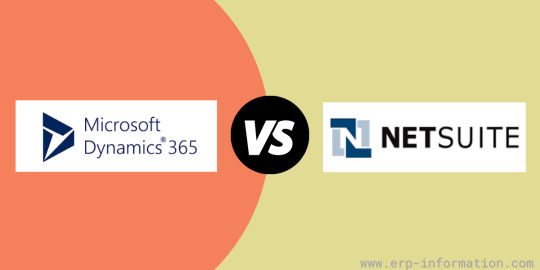

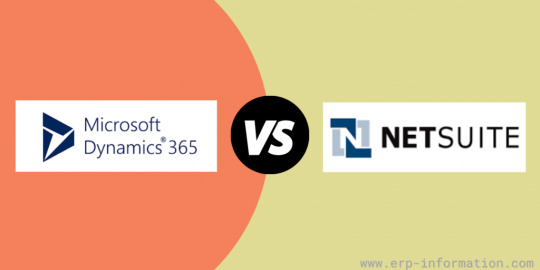
You need a new ERP system but don't know which one to choose. Microsoft Dynamics and NetSuite are two of the most popular ERP systems. However, they both have pros and cons, so how do you decide which one is right for you? This blog post explains Microsoft Dynamics vs NetSuite so you can decide which ERP system is right for your business.
Microsoft Dynamics vs NetSuite
Microsoft Dynamics is a business management software solution that helps organizations automate their business processes and improve decision-making. Dynamics is a comprehensive ERP system covering financial, supply chain, and operations management. It's available in both on-premises and cloud-based versions. NetSuite is a cloud-based ERP system that offers financials, inventory management, and e-commerce capabilities. It's a popular choice for businesses because it is easy to use and has a low total cost of ownership. NetSuite is also scalable so that it can grow with your business. Now that you know a little about each ERP system let's compare them.
Pricing
Microsoft Dynamics and NetSuite both offer subscription-based pricing models. However, Dynamics is typically more expensive than NetSuite. Therefore, NetSuite may be the better option if the price is a significant consideration. Microsoft Dynamics and NetSuite both offer a free trial. Microsoft Dynamics Subscription Details: - Dynamics 365 Business Central Essentials: $70 per user/month with a minimum of 5 users - Dynamics 365 Business Central Premium: $100 per user/month with a minimum of 5 users
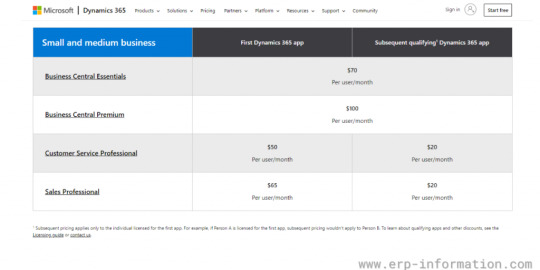
NetSuite Subscription Details: - NetSuite Starter Edition: $99 per user/month (billed annually) with a minimum of 5 users - NetSuite Professional Edition: $149 per user/month (billed annually) with a minimum of 10 users - NetSuite Enterprise Edition: $399 per user/month (billed annually) with a minimum of 20 users
Customer support
According to most customers, NetSuite has got better customer support, whereas Microsoft Dynamics has not been so good at providing customer support. NetSuite Customer support: - Live chat: available 24/7 - Phone support: available during business hours - Online training videos: in-person, live online, and webinars available on the NetSuite website Microsoft Dynamics Customer support: - Live chat: available during business hours - Phone support: available during business hours - Online training videos: available on the Microsoft website
Deployment and scalability
Both Microsoft Dynamics and NetSuite offer on-premises and cloud-based deployment options. However, NetSuite is a pure cloud solution, so it's more scalable than Dynamics. So if you're looking for an ERP system that can grow your business, NetSuite is the better choice. Microsoft Dynamics deployment options:NetSuite deployment options:On-premises: Installed on your company's serversCloud-based: Hosted by NetSuite in the cloudCloud-based: Hosted by Microsoft in the cloud
Microsoft Dynamics vs NetSuite: Focus on Which features
Both Microsoft Dynamics and NetSuite offer a comprehensive set of features and functionality. However, there are some critical differences between the two systems. For example, Dynamics offers more advanced supply chain management and CRM. NetSuite has a more robust financial and account management system than Dynamics. If you're looking for specific features, you must compare the two systems side-by-side to see which one offers the functionality you need.
Functionalities
Microsoft Dynamics functionalities
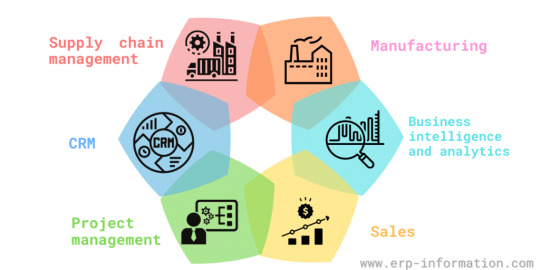
1. Supply chain management Supply chain management includes Inventory management, Warehouse management, and Transportation management. 2. CRM Customer relationship management (CRM) focuses on Salesforce automation, Marketing automation, Customer service and support, and Social listening. 3. Project management Project management deals with Project management, Service management, Field service, and Resource management.
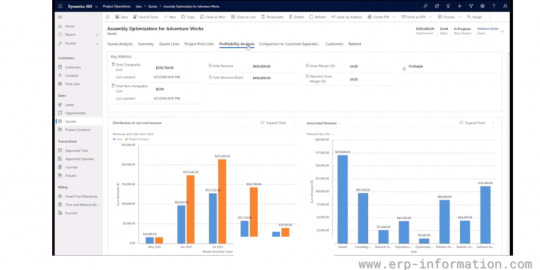
4. Manufacturing Manufacturing functionality is associated with Production management, Quality management, Manufacturing execution, and Product lifecycle management. 5. Business intelligence and analytics Business intelligence and analytics include Power BI, Excel, SQL Server Reporting Services, and custom reports. 6. Sales The sales module helps in Opportunity management, Sales forecasting, Quote and order management, and Incentive compensation management.
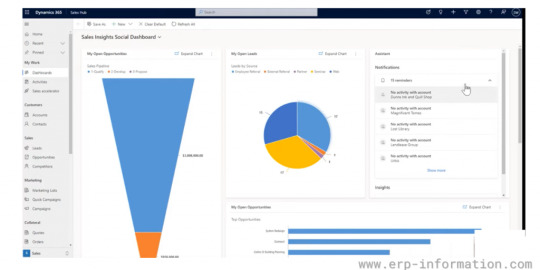
NetSuite's Main Functionalities

1. E-commerce E-commerce includes Site builder, Shopping cart, Order management, and Payment processing. 2. Financial management Financial management enables Electronic payments, Built-in accounting, fixed assets, Auditing, organizing business processes, and customizable financial reports.
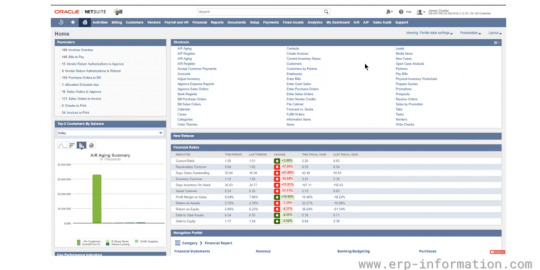
3. Supply chain management Supply chain management is accountable for inventory, warehouse, and Transportation management. 4. CRM Customer relationship management (CRM) enables Salesforce automation, Marketing automation, Customer service management, and Social listening. 5. Project management Project management helps with Project management, Service management, Field service, and Resource management.
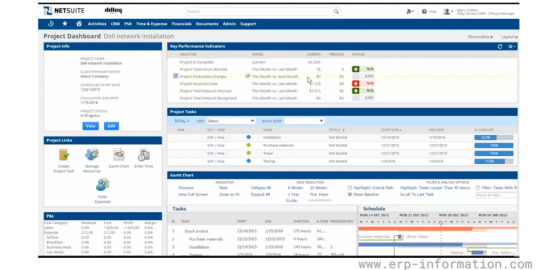
Manufacturing functionality is not available in NetSuite
Customization
Both Microsoft Dynamics and NetSuite are highly customizable. However, Dynamics offers more customization options than NetSuite. With Dynamics, you can customize the interface, workflows, and reports to fit your business needs. NetSuite also offers some customization options, but they're not as extensive as Dynamics. Dynamics is the better choice if you need a highly customized ERP system.
Implementation
Both Microsoft Dynamics and NetSuite are complex ERP systems. Therefore, they both require a significant investment of time and resources. However, Dynamics is typically more difficult to implement than NetSuite. Additionally, Dynamics requires more ongoing maintenance than NetSuite. NetSuite may be the better option if you're looking for a system that's easy to implement.
Conclusion
Which ERP system is right for you? The answer to this question depends on your specific needs. For example, NetSuite may be the better choice if you're looking for an ERP system that's highly customizable and easy to implement. However, if you need an ERP system with more advanced features and functionality, Dynamics may be the better option. Ultimately, the decision comes down to your specific needs and requirements. Read the full article
0 notes